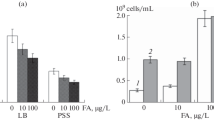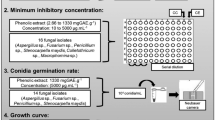Abstract
The effect of twenty-one phenolic compounds and related substances on conidial germination and appressorial formation inColletotrichum falcatum was studied.
Mono-phenol was only mildly inhibitory to spore germination at higher levels. Toxicity of di- and tri-hydroxy benzenes depended on the spatial relationship of the hydroxyl groups. The order of toxicity among the three dihydroxy isomers wasortho>para>meta. Germination inhibition followed the same pattern in the two trihydroxy isomers tested; pyrogallol was strongly toxic while phloroglucinal was without any significant effect. Methoxylation tended to abolish toxicity to spore germination as evidenced by anisole and guaiacol.
Acylation, either nuclear or side-chain, was strongly inhibitory to germination. Introduction of a carboxyl into phenol, on the other hand, dramatically brought down toxicity. Presence of a single hydroxyl group para to a carboxyl interestingly elicited strong inhibition of appressorial formation and increase in germ tube length. The limited number of phenolic compounds tested did not reveal any relationship between molecular weight and toxicity.
The presence on the nodal rind of certain phenolic substances may affect penetration of the pathogen into the host by suppressing appressorial formation,e.g., vanillic acid, ferulic acid, P-salicylic acid, P-coumaric acid and tyrosine. On the other hand their activity inside an infected tissue may facilitate rapid spread of the pathogen in the tissues and thereby lower the resistance of the host. It is suggested that different phenolic substances may be involved in the formation of dormant infections and have a bearing on epidemiology. Pathogenic strains are known to differ in the time of formation of hydrolytic enzymes. Since hydrolytic enzyme actionin vivo often releases phenols, it is suggested that the restricted virulence of certain strains is related to the earliness of formation of these enzymes.
Similar content being viewed by others
References
Clauss, E... “Die phenolischen Inhaltstaffe der Sammenschatem vonPisum sativum L. und ihre Bedeutung für die Resistenzgegen die Erreger der Fusskrankheit,”Naturwissenschaften, 1961,48, 106.
Cruickshank, I. A. M. and Perrin, D. R. “Isolation of a phytoalexin fromPisum sativum L.,”Nature, Lond., 1960,172, 959–61.
Edgerton, C. W. and Carvajal, F. “Host-parasite relations in red rot of sugarcane,”Phytopathology, 1944,34, 827–37.
Greathouse, G. A. and Rigler, N. E. “The chemistry of resistance of plants toPhymatotrichum root rot. IV. Toxicity of phenolic and related compounds,”Amer. J. Bot., 1940,27, 99–107.
Kúc, J., Henze, R. E., Ullstrup, A. J. and Quackenbush, F. W. “Chlorogenic and caffeic acids as fungistatic agents produced by potatoes in response to inoculation withHelminthosporium carbonum,”J. Amer. Chem. Soc., 1956,78, 3123–25.
Kar, K... “Variations in red rot flora in Uttar Pradesh,”Proc. bien. Confee Sug. Cane Res. Dev. Workers, 1961,4, 583–90.
Link, K. P., Angeil, H. R. and Walker, J. C. “The isolation of protocatechuic acid from pigmented onion scales and its significance in relation to disease resistance in onions,”J. biol. Chem. 1929,81, 369–75.
Martin, H. ..The Scientific Principles of Plant Protection, 2nd Edition, London, 1936.
May, P.The Chemistry of Synthetic Drugs, London, 1918.
Mueller, K. O... “Studies in phytoalexins. I. The formation and immunological significance of phytoalexin produced byPhaseolus vulgaris in response to infection withSclerotinia fructicola andPhytophthora infestans,”Australian J. biol. Sci., 1958,11, 275–300.
Rao, K. C., Krishnamoorthy, T. N., Lalitha, E. and Rajalakshmy, V. KR. “Phenols in relation to resistance of sugarcane varieties to red rot disease,”Curr. Sci., 1968,37, 532–34.
Simmonds, J. H... “Studies in the latent phase ofColletotrichum species causing ripe rots of tropical fruits,”Qd J. agric. Sci., 1963,20, 373–424.
Srinivasan, K. V... “Some observations on variation in the red rot pathogenGlomerella tucumanensis (Speg.) Arx and Muell,”Proc. intern. Soc. Sug. Cane Tech., Mauritius, 1963,11, 795–802.
—————.. “Towards the ideal of red rot resistance—Ends and Means,”Proc. intern. Soc. Sug. Cane Tech. Puerto Rico., 1965,12, 1108–17.
Srinivasan, K. V. .. “Hydrolytic enzymes and polyphenoloxidase in sugarcane red rot,”Intern. Symp. Plant Pathology. Session on “Phyto alexins and Fungal Enzymes,” New Delhi, 1967 (in press).
—————.. “Physiology of disease resistance in sugarcane with particular reference to red rot,”Proc. Ind. Acad. Sci., 1969,69 B, 120–32.
—— and Alexander, K. C. “A study of mode of nodal infection and occurrence of dormant infections in red rot,”Proc. All-India Confce, Sug. Cane Res. Dev. Workers, 1966,5, 676–84.
Walker, J. C. and Link, K. P. “The isolation of catechol from pigmented onion scales and its significance in relation to disease resistance in onions,”J. biol. chem., 1933,100, 379–83.
—————.. “Toxicity of phenolic compounds to certain onion bulb parasites,”Botan. Gaz., 1935,96, 468–84.
Author information
Authors and Affiliations
Additional information
Communicated by Prof. T. S. Sadasivan,f.a.sc.
Rights and permissions
About this article
Cite this article
Srinivasan, K.V., Narasimhan, R. The effect of certain phenolic and related compounds on spore germination and appressorial formation inColletotrichum falcatum went. Proc. Indian Acad. Sci. 74, 81–91 (1971). https://doi.org/10.1007/BF03050384
Received:
Issue Date:
DOI: https://doi.org/10.1007/BF03050384




